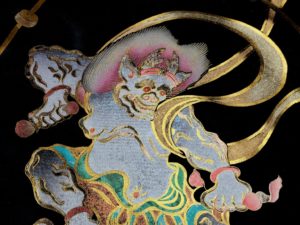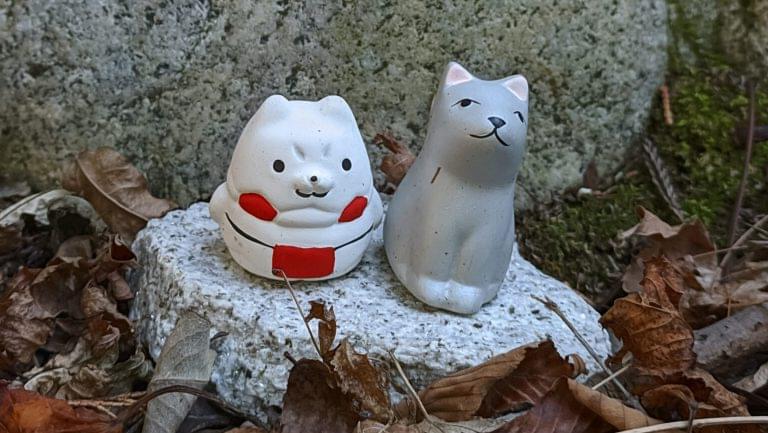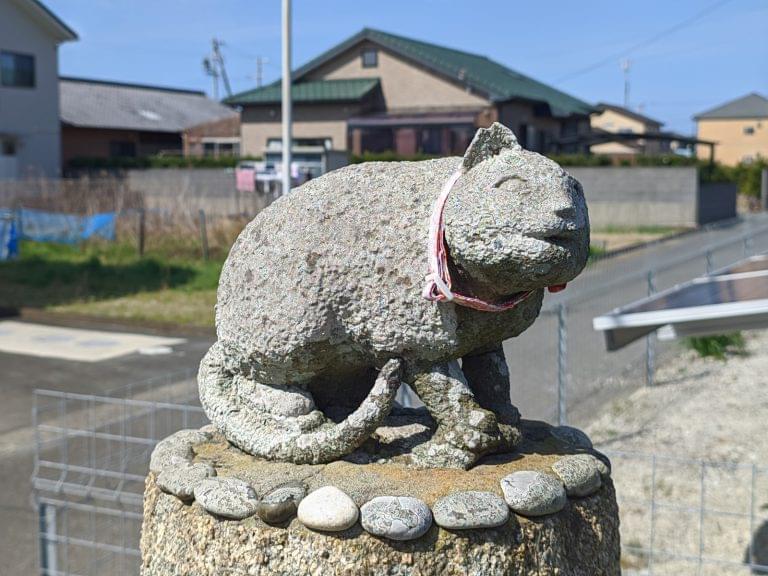Who are Fujin and Raijin (the Japanese Wind God and Thunder God), where did they come from, and what do they do? Today I’ll tell you about their origins in India and a Japanese Goddesses’ decaying body.

It’s dusk and bad weather is on its way. In the distance dark clouds churn, and roll in, and there’s the clean smell of coming-rain in the air. Echoing through the hills the low growl of thunder threatens that this is going to be a especially large storm.
You wait and watch, a queasy, excited feeling turns in your stomach. Temperature dropping, wind picking up, the sky darkens. Suddenly, the skies let loose and a crackle of lightning spiderwebs and illuminates the entire sky, a thunderclap following close behind.
It’s in that moment that you see something to the west, no someone enormous standing backlit in the blue-white flash. Another streak of lightning and you see him again.
A giant whose bright red and very well-muscled body is entirely bare except for some rough cloth wrapped around his waist, a long scarf, flapping in the wind and gold rings fastened around his wrists and ankles. But it’s the ferocious expression on his somewhat monkey-looking, upward fanged face that really gives you the willies. That with his windswept long red hair.
Another flash of lightning, roll of thunder. That’s when you noticed he’s surrounded by a ring of taiko drums, and the thunder is actually him beating the drums with the mallets he’s holding in his hands.
A huge gust of wind howls and, wait a minute, you notice another titan, this one in the east, he’s just as fierce, just as near-naked but with blue skin and holding a large air-filled bag across his shoulders.
Do you know who these two giants are? Yes, exactly. Today let’s talk about Raijin and Fujin. The gods of thunder and wind.
Hey hey,
How are you? Me? Waiting anxiously for a vaccination. Reading and hearing first hand lots of distressing news on that front. My place in line is next year. Next year! Rich Pav and I are very seriously considering going back to the States for a month to get the jab or jabs. So if any listeners who live in Japan and know anything about the numerous hoops that must be jumped and hurdles that must be hurdled, hit me up on Twitter, FB, email at uncannyjapan@gmail.com . I’ll send you stickers!
Okay, on to today’s show.
Who Are Raijin and Fujin?
Fujin (風神) and Raijin (雷神), are two Japanese deities, usually seen together in art as well as in the wild. Fuujin means Wind God and Raijin mean Thunder God. Very straightforward. Well, not really. It’s going to get weird.
Fujin and Raijin are usually are depicted much like what I described in the beginning. Rippling muscles, an arm and leg raised as if they’re about to lunge or are maybe stomping the clouds. Raijin’s got his ring of drums behind him, holding what looks like a small barbell that he uses to beat them (maybe thunder). His hair is all blown back away from his fanged open grimacing mouth. Fujin’s wielding this pillowy, wind-filled tube thing over his shoulders, pointy ears, just as angry, but what I think looks more like a bat-like face than monkey.
Indian Origins
So where did they come from originally? Well, one lineage is India, of course.
It’s said they are based on two Indian deities, Vayu and Varun, who look completely different. Vayu, the god of wind or breath, is usually blue skinned, wearing more and more ornate clothing, and not nearly as macho as Fujin. He rides a gazelle and the only resemblance I can find to the Japanese god of wind is the gold rings around his wrists and ankles.
I couldn’t find much about a Varun, but there is the Indian god Indra, who is a storm and thunder god, carries a hammer like instrument, rides a white elephant. Now, I’m not going to say anything about anything, but if you follow Raijin, Japan’s god of thunder back, back, back, you not only bump into Varun or Indra, but also Thor and Zeus. Fascinating.
Chinese Legend
And of course you can’t get to Japan without crossing through China where there is a legend about how they were originally demons who opposed the Buddha. This caused the Buddha to call on his heavenly army to try and capture the two. But they were tough cookies and after a very long battle between the two of them and 33 other gods (on Buddha’s side) they were finally caught. Since then they’ve been working for heaven.
Japanese Legend
In Japanese Raijin (雷神) is also called kaminari sama 雷様, raiden sama (雷電様), narukami (鳴神), and raikou (雷公) and there is a Japanese legend that says he saved Japan from a Mongolian invasion in 1274. Imagine Raijin sitting on a cloud and bombarding the army by throwing lightning arrows down at them until they turned tail and fled.
It’s interesting that while these two aren’t originally Buddhist in origin, they were added to the One-Thousand Armed Kannon, or the Senju Kannon’s 28 attendants, called Nijuuhachi Bushuu (二十八部衆).
Separation of Buddhism and Shintoism
Now, what’s even more interesting than that is how in Japan back in the day, Buddhism and Shintoism were quite friendly. That is until then the new Meiji government enacted a law called the Shinbutsu Bunri (神仏分離), the separation of Buddhism and Shintoism in 1868.
Before this law you could have a temple or shrine used for both religions and it was cool. Shinto gods were thought to be manifestations of Buddhas and everyone held hands and kumbaya, fine. But then nationalism rose its nasty little head and Buddhism was thought to be this outside religion, which it was, and bad, which it wasn’t, and a wave of anti-Buddhism swept over the country. Hundreds and hundreds of temples were closed, land seized, sacred texts and statues destroyed, and monks told to become Shinto priests or else. It’s said this wasn’t strictly ordered by the government, but kind of implied and everyone just went along with it. I know horrible, right?
A bit of good news was that in 1873 the government admitted it’s attempt to stamp out Buddhism failed. One reason might be that Buddhism handled funerals, and all the ceremony and rites around them. People couldn’t simply give that up. So the laws became a little more relaxed.
So it’s interesting to see how the two religions kind of merge and borrow from each other sometimes. An example being, These two gods of thunder and wind who traveled from India, through China, then landed in Japan, were added to the Kannon’s attendants — Kannon being of the Buddhist tradition — and also, deeply rooted in Shinto.
Shinto Origin
You can find the tale of them being some of the oldest Shinto gods. You see, it’s a very long and very strange story, but the gist of it is: the Shinto god Izanagi went to a place called Yomi to retrieve his dead wife, whom he found rotting and covered in maggots and monsters. He was like nuh uh, sufficiently repulsed. This made the dead Izanami furious. So she gets up along with a few of the monsters that had been birthed from her decaying corpse and chases after him. Izanagi manages to block the entrance to Yomi, but not before a couple of those demons escape. Who escaped? Why Fujin and Raijin, of course. Isn’t that great?
Superstition
So next time there’s a thunderstorm, just imagine Raijin and Fujin up there, pounding on drums and squeezing a bag full of wind. Oh, and also, let me leave you with a superstition: in Japan it’s believed that if you hear thunder you have to hide (put your hands over) your belly button or else Raijin will swoop in and steal it!
There are two thoughts about why this superstition started. One, that when the weather turns bad, the temperature falls, and if you have your belly sticking out you might catch a cold, so hide your belly button. Two, that if you’re outside and it’s thundering and lightninging if you curl up, thus hiding your belly button, it will make you small and less likely to get struck by lightning. That’s what I read.
Okay, I’ll leave you here today.
Thank you so much for listening, stay safe and well, and away from Fujin and Raijin, else they steal your belly button, and I will talk to you again in two weeks.
Bye bye
Credits
Intro and outro music by Julyan Ray Matsuura.






